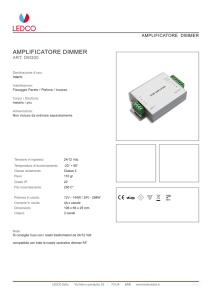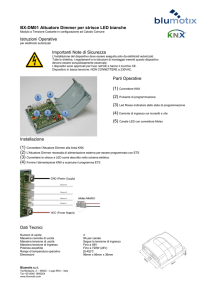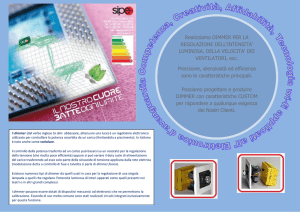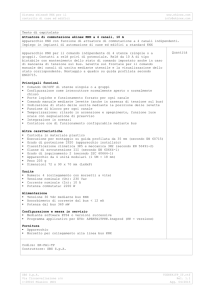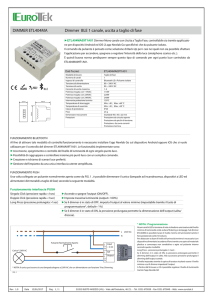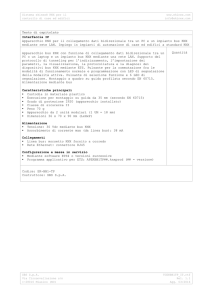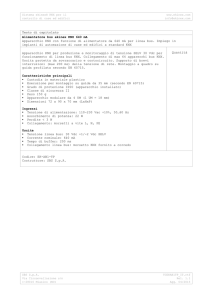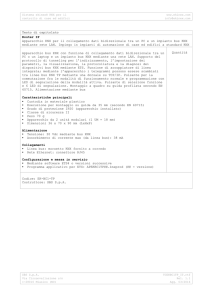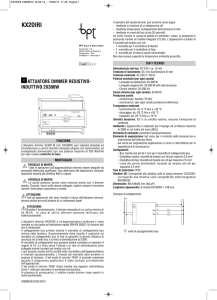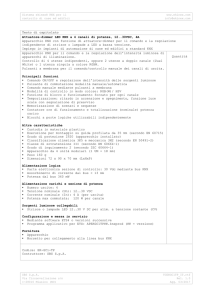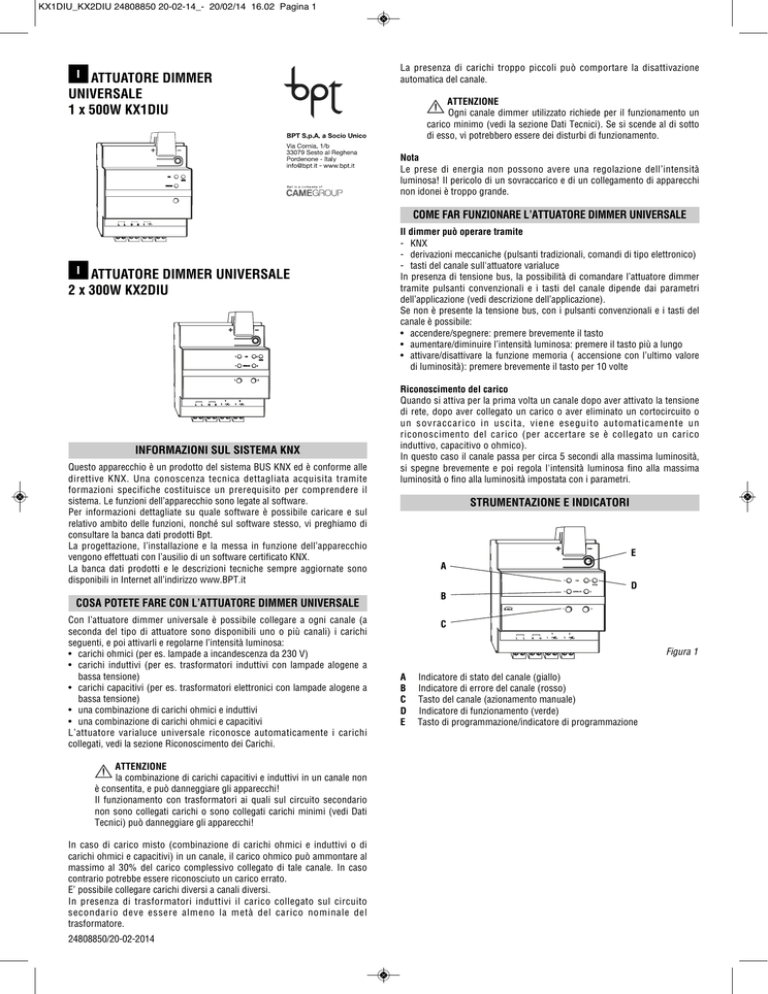
KX1DIU_KX2DIU 24808850 20-02-14_- 20/02/14 16.02 Pagina 1
I
ATTUATORE DIMMER
UNIVERSALE
1 x 500W KX1DIU
La presenza di carichi troppo piccoli può comportare la disattivazione
automatica del canale.
ATTENZIONE
Ogni canale dimmer utilizzato richiede per il funzionamento un
carico minimo (vedi la sezione Dati Tecnici). Se si scende al di sotto
di esso, vi potrebbero essere dei disturbi di funzionamento.
Nota
Le prese di energia non possono avere una regolazione dell’intensità
luminosa! Il pericolo di un sovraccarico e di un collegamento di apparecchi
non idonei è troppo grande.
COME FAR FUNZIONARE L’ATTUATORE DIMMER UNIVERSALE
I
ATTUATORE DIMMER UNIVERSALE
2 x 300W KX2DIU
INFORMAZIONI SUL SISTEMA KNX
Questo apparecchio è un prodotto del sistema BUS KNX ed è conforme alle
direttive KNX. Una conoscenza tecnica dettagliata acquisita tramite
formazioni specifiche costituisce un prerequisito per comprendere il
sistema. Le funzioni dell’apparecchio sono legate al software.
Per informazioni dettagliate su quale software è possibile caricare e sul
relativo ambito delle funzioni, nonché sul software stesso, vi preghiamo di
consultare la banca dati prodotti Bpt.
La progettazione, l’installazione e la messa in funzione dell’apparecchio
vengono effettuati con l’ausilio di un software certificato KNX.
La banca dati prodotti e le descrizioni tecniche sempre aggiornate sono
disponibili in Internet all’indirizzo www.BPT.it
Il dimmer può operare tramite
- KNX
- derivazioni meccaniche (pulsanti tradizionali, comandi di tipo elettronico)
- tasti del canale sull'attuatore varialuce
In presenza di tensione bus, la possibilità di comandare l’attuatore dimmer
tramite pulsanti convenzionali e i tasti del canale dipende dai parametri
dell’applicazione (vedi descrizione dell’applicazione).
Se non è presente la tensione bus, con i pulsanti convenzionali e i tasti del
canale è possibile:
• accendere/spegnere: premere brevemente il tasto
• aumentare/diminuire l’intensità luminosa: premere il tasto più a lungo
• attivare/disattivare la funzione memoria ( accensione con l’ultimo valore
di luminosità): premere brevemente il tasto per 10 volte
Riconoscimento del carico
Quando si attiva per la prima volta un canale dopo aver attivato la tensione
di rete, dopo aver collegato un carico o aver eliminato un cortocircuito o
un sovraccarico in uscita, viene eseguito automaticamente un
riconoscimento del carico (per accertare se è collegato un carico
induttivo, capacitivo o ohmico).
In questo caso il canale passa per circa 5 secondi alla massima luminosità,
si spegne brevemente e poi regola l'intensità luminosa fino alla massima
luminosità o fino alla luminosità impostata con i parametri.
STRUMENTAZIONE E INDICATORI
E
A
D
B
COSA POTETE FARE CON L’ATTUATORE DIMMER UNIVERSALE
Con l’attuatore dimmer universale è possibile collegare a ogni canale (a
seconda del tipo di attuatore sono disponibili uno o più canali) i carichi
seguenti, e poi attivarli e regolarne l’intensità luminosa:
• carichi ohmici (per es. lampade a incandescenza da 230 V)
• carichi induttivi (per es. trasformatori induttivi con lampade alogene a
bassa tensione)
• carichi capacitivi (per es. trasformatori elettronici con lampade alogene a
bassa tensione)
• una combinazione di carichi ohmici e induttivi
• una combinazione di carichi ohmici e capacitivi
L’attuatore varialuce universale riconosce automaticamente i carichi
collegati, vedi la sezione Riconoscimento dei Carichi.
ATTENZIONE
la combinazione di carichi capacitivi e induttivi in un canale non
è consentita, e può danneggiare gli apparecchi!
Il funzionamento con trasformatori ai quali sul circuito secondario
non sono collegati carichi o sono collegati carichi minimi (vedi Dati
Tecnici) può danneggiare gli apparecchi!
In caso di carico misto (combinazione di carichi ohmici e induttivi o di
carichi ohmici e capacitivi) in un canale, il carico ohmico può ammontare al
massimo al 30% del carico complessivo collegato di tale canale. In caso
contrario potrebbe essere riconosciuto un carico errato.
E’ possibile collegare carichi diversi a canali diversi.
In presenza di trasformatori induttivi il carico collegato sul circuito
secondario deve essere almeno la metà del carico nominale del
trasformatore.
24808850/20-02-2014
C
Figura 1
A
B
C
D
E
Indicatore di stato del canale (giallo)
Indicatore di errore del canale (rosso)
Tasto del canale (azionamento manuale)
Indicatore di funzionamento (verde)
Tasto di programmazione/indicatore di programmazione
KX1DIU_KX2DIU 24808850 20-02-14_- 20/02/14 16.02 Pagina 2
Significato degli indicatori
Indicatore di
funzionamento
(verde)
acceso
Indicatore di
stato del canale
(giallo)
spento
acceso
acceso
acceso
spento
acceso
acceso
spento
spento
spento
acceso
spento
spento
spento
acceso
lampeggia
acceso/spento
Indicatore di
errore del canale
(rosso)
spento
Attuatore dimmer universale
pronto per il funzionamento
(tensione di rete e tensione bus
presenti) e canale disattivato
spento
Attuatore dimmer universale
pronto per il funzionamento
(tensione di rete e tensione bus
presenti), canale attivato (oggetto
del collegamento = „1") o
riconoscimento del carico
acceso
Sovraccarico o cortocircuito.
Il canale si è disinserito. Tensione
di rete e tensione bus presenti
acceso
Nessun carico in uscita
(corrente a vuoto). Il canale si
è disinserito. Tensione di rete
e tensione bus presenti
spento
Tensione bus non presente
e canale disinserito o tensione
di rete non presente
spento
Tensione bus non presente
e canale attivato
acceso
Sovraccarico o cortocircuito
e tensione bus non presente.
Il canale si è disinserito.
acceso
Nessun carico in uscita (corrente a
vuoto) e tensione bus non
presente. Il canale si è disinserito.
tutti accesi
Sovratemperatura: tutti i canali
inseriti vengono impostati sulla
luminosità/potenza minima. I canali
disattivati non possono essere
attivati. Vedi anche la sezione
“Come riconoscere i possibili guasti”.
COME MONTARE L’ATTUATORE DIMMER UNIVERSALE
ATTENZIONE
Tutti gli apparecchi montati accanto all’attuatore dimmer devono
essere dotati almeno di un isolamento base.
B
C
Figura 2
A
B
C
1 Agganciare sulla guida profilata da 35 x 7,5 mm come da DIN EN 50022
(un esempio di collegamento è illustrato nella Figura 2).
2 Collegare il connettore bus e infilare la copertura del morsetto bus (un
esempio di collegamento è illustrato nella Figura 3).
3 Collegare le linee per la tensione di rete, le uscite e gli ingressi dei comandi
convenzionali (un esempio di collegamento è illustrato nella Figura 4).
Pericolo di morte dovuto alla corrente elettrica.
Anche quando il dimmer è spento vi può essere tensione alle uscite.
Durante l’installazione rispettare le norme di sicurezza.
L’apparecchio può essere installato solo da un elettricista
specializzato, in caso contrario vi può essere pericolo di incendio o
pericolo di scosse elettriche!
ATTENZIONE
Gli ingressi dei comandi convenzionali devono essere collegati alla
stessa fase dell'alimentazione di rete dell’attuatore dimmer.
In tutti gli attuatori dimmer universali i due morsetti per il
collegamento L e i due per il collegamento N sono collegati
internamente con un ponticello.
A seconda del tipo di attuatore dimmer, i collegamenti dell’uscita
dimmer e dell’ingresso dei comandi convenzionali di un canale sono
costituiti da singoli morsetti o da due morsetti collegati internamente
con un ponticello (fare attenzione alle diciture).
COME METTERE IN FUNZIONE L’ATTUATORE DIMMER UNIVERSALE
PERICOLO DI MORTE:
Tutti gli interventi sull’apparecchio possono essere eseguiti solo da
elettricisti specializzati.
Vi preghiamo di osservare le disposizioni specifiche del luogo di
installazione nonché le direttive KNX in vigore!
1 Caricare l’indirizzo fisico dall’ETS nell’attuatore dimmer universale
via KNX.
2 Inserire le impostazioni di configurazione nell’ETS e trasmetterle.
COME RICONOSCERE I POSSIBILI GUASTI
PERICOLO DI MORTE:
Tutti gli interventi sugli impianti elettrici possono essere eseguiti solo
da elettricisti specializzati.
La luminosità delle lampade collegate si riduce al minimo (le lampade
potrebbero spegnersi automaticamente).
Se la temperatura nell'attuatore dimmer universale è troppo elevata,
l'intensità luminosa di tutti i canali inseriti viene regolata sulla
luminosità/potenza minima.
E’ possibile solo disattivare i canali, non è più possibile attivarli o regolarne
l'intensità luminosa. Se la temperatura si riabbassa entro circa 15 minuti, i
valori precedenti vengono reimpostati.
Se la temperatura aumenta ulteriormente, i canali vengono automaticamente
disattivati.
E’ possibile riattivare i canali solo quando la temperatura si è notevolmente
abbassata. I comandi KNX nel frattempo vanno persi.
Successivamente è possibile ritornare a utilizzare normalmente l’attuatore
dimmer universale.
Una temperatura troppo elevata dell’attuatore dimmer universale è legata
per lo più a un sovraccarico delle uscite o a una dissipazione di calore
insufficiente dell’attuatore.
In presenza di diversi attuatori dimmer montati l’uno accanto all’altro è
possibile che si verifichi anche un “riscaldamento” reciproco.
Le cause dell’aumento della temperatura dovranno essere eliminate
da un elettricista specializzato prima di rimettere nuovamente in
funzione l’apparecchio.
D
Figura 3
La lampada collegata si spegne automaticamente e non è più possibile
riaccenderla, né può esserne regolata l'intensità luminosa.
10 A
L
N
In presenza di un cortocircuito o di un sovraccarico il canale corrispondente
si disinserisce, e l'indicatore di errore del canale si accende.
In presenza di trasformatori induttivi il carico collegato sul circuito
secondario deve essere almeno la metà del carico nominale del
trasformatore.
La presenza di carichi troppo ridotti può comportare la disinserzione
automatica del canale.
+
Bus
-
Figura 4
Le cause dovranno essere eliminate da un elettricista specializzato. Quando
KX1DIU_KX2DIU 24808850 20-02-14_- 20/02/14 16.02 Pagina 3
si attiva il canale per la prima volta dopo aver eliminato la causa del guasto,
viene eseguito automaticamente un riconoscimento del carico.
Successivamente è possibile ritornare a utilizzare normalmente l’attuatore
dimmer universale.
Tutte le lampade collegate si spengono automaticamente, e non è più
possibile riaccenderle, né può essere regolata l'intensità luminosa.
La tensione di rete si è interrotta. Dopo aver riattivato la tensione di rete i
canali rimangono disattivati. Quando si attiva un canale per la prima volta
dopo aver attivato la tensione di rete, viene eseguito automaticamente un
riconoscimento del carico.
In assenza di tensione bus, quando si accende la lampada tramite il
pulsante convenzionale o il tasto del canale, essa non può essere
attivata alla massima luminosità.
La funzione memoria è attivata. La lampada si accende con l’ultimo valore di
luminosità. Per commutare (funzione memoria accesa/spenta) premere il
tasto brevemente per 10 volte.
COSA SI PUÒ FARE SENZA TENSIONE BUS
Se non è presente la tensione bus (l’indicatore di funzionamento è spento), le
lampade collegate possono essere accese o si può variarne l’intensità luminosa
tramite i tasti del canale o i relativi pulsanti collegati agli ingressi convenzionali.
L’intensità luminosa aumenta o diminuisce in continuo fino a quando il
tasto rimane premuto.
Le impostazioni effettuate tramite l’ETS non sono disponibili.
DATI TECNICI
Alimentazione dal bus: DC 24V/circa 5 mA
Tensione di isolamento: AC 4 kV Bus/Tensione di rete
Tensione nominale: AC 220 – 230 V, 50/60 Hz
L’attuatore dimmer universale deve essere protetto tramite un
interruttore automatico da 10 A collegato in serie.
I dimmer KNX KX1DIU e KX2DIU devono essere impiegati in contesti in cui
l'alimentazione di rete presenti stabilità dei parametri elettrici, in particolare
della frequenza, (tale condizione è sempre assicurata dagli enti fornitori di
energia); pertanto l'uso di questi dimmer è assolutamente sconsigliato in
quelle applicazioni dove non si ha certezza della stabilità della frequenza,
ovvero quando l'energia è generata mediante degli inverter: (ad es. le
imbarcazioni sono un caso tipico in cui l'uso dei dimmer KX1DIU e KX2DIU
è assolutamente sconsigliato).
I dimmer universali KX1DIU e KX2DIU in presenza di variazioni di frequenza
al di fuori dei limiti prescritti attivano la procedura di riconoscimento della
natura del carico (R/L o R/C) che consiste nell'abbassare e rialzare
gradualmente il livello di illuminamento. In questi casi si potranno utilizzare
gli altri dimmer KNX presenti nel catalogo Bpt.
Potenza nominale
- KX1DIU:
carichi ohmici
10 - 500 W
carichi induttivi
50 - 500 VA
carichi capacitivi 50 - 500 VA
- KX2DIU (entrambi i canali sono utilizzati, per canale):
carichi ohmici
10 -300 W
carichi induttivi
50 -300 VA
carichi capacitivi 50 -300 VA
- KX2DIU (solo un canale è utilizzato):
carichi ohmici
10 - 500 W
carichi induttivi
50 - 500 VA
carichi capacitivi
50 - 500 VA
I valori di potenza massimi indicati sono per una frequenza di rete di 50
Hz e una temperatura ambiente fino a circa 35 °C.
In caso di funzionamento con una tensione di rete di 60 Hz i valori di
potenza massimi si riducono di circa il 15%.
La variazione della potenza legata alla temperatura ambiente può essere
rilevata dal diagramma illustrato di seguito.
100%
80%
60%
40%
20%
0%
-5
0
10
20
30 35 40 45 °C
Temperatura ambiente:
Esercizio:
da -5 °C fino a +45 °C
Deposito:
da -25 °C fino a +55 °C
da -25 °C fino a +70 °C
Trasporto:
Umidità max.: 93% di umidità relativa, nessuna condensa
Ambiente: L’apparecchio è stato progettato per essere utilizzato a una
altezza non superiore a 2000 m s.l.m.
Tipo di protezione: IP 20
Collegamenti:
- Ingressi, uscite: morsetti a vite
unifilare (rigido) da 1,5 mm2 fino a 2,5 mm2
multifilare (flessibile): da 1,5 mm2 fino a 2,5 mm2
- BUS KNX: morsetto bus
- Lunghezza massima di linea tra il pulsante convenzionale e il relativo
ingresso sull’attuatore:
pulsante di tipo meccanico
100 m
pulsante di tipo elettronico
20 m
- Tensione nominale per i pulsanti convenzionali:
AC 220 - 230 V, 50/60 Hz (fase uguale al collegamento di rete)
Funzioni di protezione:
- Riconoscimento elettrico del carico
- Riconoscimento di cortocircuito, sovraccarico e di corrente a vuoto
- Riconoscimento della sovratemperatura
(temperatura dell’attuatore dimmer)
Direttive:
- Direttiva sulla bassa tensione 73/23/CEE
- Direttiva sulla compatibilità elettromagnetica 85/336/CEE
KX1DIU_KX2DIU 24808850 20-02-14_- 20/02/14 16.02 Pagina 4
EN
UNIVERSAL DIMMER
1 x 500W KX1DIU
CAUTION
Each dimming channel used requires a minimum load for operation
(see technical data). If this is not achieved, malfunctions may arise.
Note
Socket-outlets may not be dimmed. The risk of overloading and the risk of
unsuitable appliances being connected is too high.
HOW TO OPERATE THE UNIVERSAL DIMMING ACTUATOR
EN
UNIVERSAL DIMMER
2 x 300W KX2DIU
Operate the dimmer via one of the following:
- KNX
- Mechanical extension unit (conventional push-button, electronic
extension units)
- Channel buttons on the dimming actuator
If bus voltage is available, operation via the extension units and channel
buttons depends on the parameters of the application (see the separate
application description).
If there is no bus voltage, you can do the following with the extension units
and channel buttons:
• Switch on/off: press the button briefly
• Dim brighter/darker: press the button and hold it down
• memory function (switch on at last brightness value) on/off: press the
button briefly 10 times
Load detection
The first time a channel is switched after the mains voltage is switched on,
after a load is connected or after a short circuit or overload at the output
has been rectified,
load detection will be carried out automatically (to determine whether an
inductive, capacitive or ohmic load is connected).
When this happens, the channel switches on for approx. 5 seconds at the
maximum brightness, is then extinguished briefly, and then dims up to the
maximum brightness or the parameterised brightness.
KNX SYSTEM INFORMATION
This device is an BUS KNX system product and conforms to KNX
guidelines.
Detailed expertise gained through training in the BUS system is a
prerequisite.
The function of the device depends on the software used. Detailed
information on which software can be loaded and the range of functions
associated with each type of software, and the software itself, are available
from the Bpt product database.
Planning, installation and commissioning of the device are carried out
using KNX-certified software. The product database and the technical
descriptions are updated regularly and can be found on the Internet at
www.BPT.it
OPERATING AND DISPLAY ELEMENTS
E
A
D
B
C
WHAT YOU CAN DO WITH THE UNIVERSAL DIMMING ACTUATOR
The Bpt universal dimming actuator allows you to connect the following
loads to each channel and then switch and dim them (depending on the
type of universal dimming actuator you have, you will have one or more
than one channel available):
• ohmic loads (e.g. 230 V incandescent lamps)
• inductive loads (e.g. inductive transformers with low-voltage halogen
lamps)
• capacitive loads (e.g. electronic transformers with low-voltage halogen
lamps)
• a combination of ohmic and inductive loads
• a combination of ohmic and capacitive loads
The universal dimming actuator automatically recognises the connected
loads - see the section on load detection.
CAUTION
The combination of capacitive and inductive loads on one channel is
not permitted, and can damage the devices. Using transformers to
which no load or insufficient loads are connected on the secondary
circuit (see technical data) can damage the devices.
In the case of a mixed load (combination of ohmic and inductive, or
ohmic and capacitive loads) on one channel, the ohmic load may not
exceed 30% of the total connected load of this channel. Otherwise, the
wrong load might be detected.
Different loads may be connected to different channels.
When using inductive transformers, the load connected on the secondary
circuit must be at least half the size of the nominal load of the transformer.
If the load is too small, the channel may shut down automatically.
Figure 1
using the example REG-K/4x230/150W in Figure 1:
A Channel status display (yellow)
B Channel fault indication (red)
C Channel button (manual mode)
D Operating display (green)
E Programming button / Programming display
KX1DIU_KX2DIU 24808850 20-02-14_- 20/02/14 16.02 Pagina 5
Meaning of the displays
1
Channel status
display
(yellow)
off
Operating
display
(green)
on
Channel fault
indication
(red)
off
on
on
off
on
off
on
on
on
on
off
off
off
off
on
off
off
off
on
off
on
on
flashes
on/off
all on
Universal dimming actuator ready
for operation (mains voltage and
bus voltage available) and channel
switched off
Universal dimming actuator
ready for operation
(mains voltage and bus voltage
available), channel switched
on (switching object = "1")
or load detection
Overload or short circuit.
The channel has shut down.
Mains and bus voltage available
No load at output (idle).
The channel has shut down.
Mains and bus voltage available
No bus voltage
and channel switched off,
or no mains voltage
No bus voltage and channel
switched on
Overload or short circuit
and no bus voltage.
The channel has shut down.
No load at output (idle)
and no bus voltage.
The channel has shut down.
Excess temperature. All channels
that are switched on are dimmed
to minimum power/minimum
brightness. Channels which
are currently switched off cannot
be switched on. See also the
section "How to recognise faults".
HOW TO INSTALL THE UNIVERSAL DIMMING ACTUATOR
CAUTION
All devices that are installed next to the dimming actuator must be
equipped with at least basic insulatio!
B
C
Figure 2
A
B
Snap onto a 35 x 7.5 mm DIN profile rail which conforms to standard
DIN EN 50022 (refer to Fig. 2 for an example).
2 Connect the bus plug and attach the cover of the bus connecting terminal.
(refer to Fig. 3 for an example).
3 Connect the cables for the mains supply, the outputs and the extension
inputs (refer to Fig. 4 for an example).
Risk of electrocution.
The outputs may carry an electrical voltage even when the dimmer
is switched off. During installation, the safety regulations must be
observed.
The device may only be installed by skilled electricians.
Otherwise, there is a risk of fire or electrocution.
CAUTION
The extension inputs must be connected to the same phase as the
power supply of the dimming actuator.
Both connecting terminals for the L and the N connection are
jumpered internally for all universal dimming actuator types.
The connections of the dimming output and the extension input of
a channel are either individual terminals or two internally jumpered
terminals (pay attention to the marking), depending on the
dimming actuator type.
HOW TO SET UP THE UNIVERSAL DIMMING ACTUATOR
DANGER OF FATAL INJURY:
All work carried out on the unit may only be performed by skilled
electricians.
Observe the regulations valid in the country of use, as well as the
valid KNX guidelines.
1 Load the physical address from the ETS into the universal dimming
actuator via KNX.
2 Make the configuration settings in ETS and transfer them.
HOW TO RECOGNISE FAULTS
DANGER OF FATAL INJURY:
All work on electrical installations may only be performed by
qualified electricians.
The brightness of the connected lamps is reduced to a minimum (the
lamps might then switch off automatically).
If the temperature in the universal dimming actuator is too high, all the
channels which are switched on will be dimmed to minimum
power/brightness. You can now only switch the channels off - you can no
longer switch them on, or dim them.
If the temperature decreases again within approx. 15 minutes, the previous
values will be re-established. If the temperature increases further, the
channels will be switched off automatically.
You can then only switch the channels on again when the temperature has
decreased significantly. Any KNX commands received in the intervening
period will be lost.
Afterwards, you can use the universal dimming actuator as normal again.
Excessive temperature in the universal dimming actuator is normally caused
by overloading the outputs, or insufficient heat dissipation from the
universal dimming actuator.
When several dimming actuators are installed next to one another, they
might cause each other to heat up.
Make sure that an electrician detects and remedies the cause of the
increased temperature before putting the device back into operation.
C
D
The connected lamps switch off automatically and can no longer be
switched or dimmed.
Figure 3
10 A
L
N
+
Bus
-
Figure 4
In the case of a short circuit or an overload, the corresponding channel
switches off and the channel fault indication lights up.
When using inductive transformers, the load connected on the secondary
circuit must be at least half the size of the nominal load of the
transformer.
If the load is too small, the channel may shut down automatically.
Ensure that an electrician rectifies the cause.
The first time the channel is switched after the fault is rectified, load
detection will be carried out automatically.
Afterwards, you can use the universal dimming actuator as normal again.
KX1DIU_KX2DIU 24808850 20-02-14_- 20/02/14 16.02 Pagina 6
All connected lamps switch off automatically and can no longer be
switched or dimmed.
The mains voltage has failed. Once the mains voltage is switched on
again, the channels remain switched off.
The first time the channel is switched after the mains voltage is switched
on, load detection will be carried out automatically.
If there is no bus voltage, the lamp will not be switched to its full
brightness if it is switched on via the extension unit or the channel button.
The memory function is switched on. The lamp is switched on at the
previous brightness value. To toggle (memory function on/off), press the
button briefly ten times.
WHAT YOU CAN DO WITHOUT THE BUS VOLTAGE
If there is no bus voltage (operating display off), you can switch and dim the
connected luminaires with the channel buttons or use the push-buttons
connected to the extension inputs.
Dimming will be continuous (up or down) for the duration of the pushbutton action.
The settings made via the ETS will not be available.
TECHNICAL DATA
Power supply from the bus: DC 24 V/ca. 5 mA
Insulation voltage: AC 4 kV bus/mains voltage
Nominal voltage: AC 220 - 230 V, 50/60 Hz
Fuse the universal dimming actuator using a 10 A circuit-breaker
connected in series.
The KNX KX1DIU and KX2DIU dimmers must be used where the mains
supply offers stable electric parameters, especially the frequency (this
condition is always guaranteed by the energy providers); the use of these
dimmers is therefore absolutely unadvisable in those applications where
frequency stability is uncertain, or when the energy is generated by means
of inverters: (boats are a typical example of where the use of the KX1DIU
and KX2DIU dimmers is not at all advisable). With frequency variations
beyond the prescribed limits, the universal KX1DIU and KX2DIU dimmers
activate the procedure for load recognition (R/L or R/C), which involves
lowering and then gradually increasing the lighting level. In these cases, the
other KNX dimmers of the Bpt catalogue can be used.
Nominal output
- KX1DIU:
ohmic loads
10 - 500 W
inductive loads
50 - 500 VA
capacitive loads
50 - 500 VA
- KX2DIU (both channels assigned, per channel):
ohmic loads
10 -300 W
inductive loads
50 -300 VA
capacitive loads
50 -300 VA
- KX2DIU (only one channel assigned):
ohmic loads
10 - 500 W
inductive loads
50 - 500 VA
capacitive loads
50 - 500 VA
The maximum power values specified assume a mains frequency of 50 Hz
and an ambient temperature up to approx. 35°C.
When operating with a mains frequency of 60 Hz, the maximum power
values are reduced by approx. 15%.
The changes in power relative to the ambient temperature can be seen in the
diagram which follows.
100%
80%
60%
40%
20%
0%
-5
0
10
20
30 35 40 45 °C
Ambient temperature:
- Operation:
da -5 °C to +45 °C
- Storage:
da -25 °C to +55 °C
- Transport:
da -25 °C to +70 °C
Max. humidity: 93 % relative humidity, no moisture condensation
Environment: the device is designed for use at an installation height of up
to 2000 m above sea level (MSL)
Type of protection: IP 20
Connections:
- Inputs, outputs: morsetti a vite
single-core: 1.5 mm2 to 2.5 mm2
finely stranded (with connector sleeve):
1.5 mm2 to 2.5 mm2
- BUS KNX: bus connecting terminal
- Maximum cable length between extension input and extension:
mechanical extension units
100 m
electrical extension units (e.g. art. no. 573999) 20 m
(max. 10 with a max. total cable length of 20 m)
- Nominal voltage of extension units: AC 220 - 230 V, 50/60 Hz
(identical phase to mains connection)
Protective functions:
- Electrical load detection.
- Short-circuit, overload and idling detection
- Overtemperature detection (dimming actuator temperature)
Guidelines:
- 73/23/EEC low-voltage guideline
- 85/336/EEC EMC guideline
KX1DIU_KX2DIU 24808850 20-02-14_- 20/02/14 16.02 Pagina 7
KX1DIU_KX2DIU 24808850 20-02-14_- 20/02/14 16.02 Pagina 8

